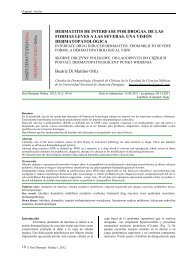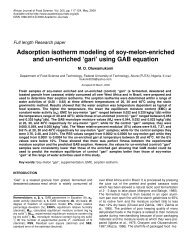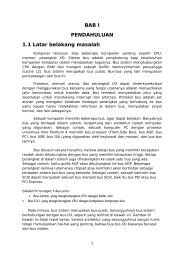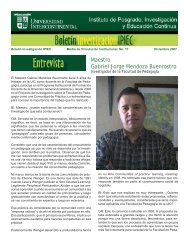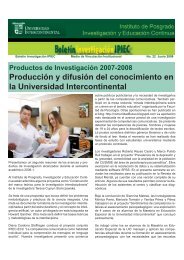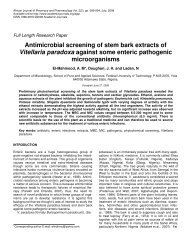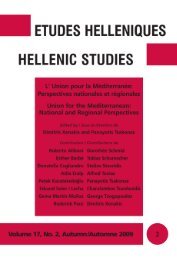wheat composite flour and bread - Science Stage
wheat composite flour and bread - Science Stage
wheat composite flour and bread - Science Stage
Create successful ePaper yourself
Turn your PDF publications into a flip-book with our unique Google optimized e-Paper software.
88 Afr. J. Food Sci.<br />
Table 1. Proximate composition of the <strong>composite</strong> <strong>flour</strong> samples.<br />
Sample Moisture (%) Protein (%) Fat (%) Ash (%) Fibre (%) Carbohydrate(By Diff)<br />
A 14.7+0.1 c 15.1+0.3 f 1.3+0.3 a 0.45+0.01 a 0.3+0.1 a 68.7<br />
B 14.4+0.1 bc 12.9+0.5 de 4.6+0.2 b 0.8+0.02 b 0.8+0.1 ab 66.5<br />
C 14.4+0.0 bc 12.0+0.4 cd 7.7+0.3 c 1.1+0.02 c 1.4+0.4 bc 63.4<br />
D 14.2+0.0 b 11.1+0.3 bc 11.0+0.3 d 1.2+0.01 d 2.0+0.4 cd 60.5<br />
E 13.8+0.2 a 10.2+0.3 ab 14.0+0.2 e 1.4+0.01 e 2.6+0.3 de 58.0<br />
F 13.8+0.1 a 9.4+0.5 a 17.3+0.4 f 1.6+0.01 f 3.2+0.1 e 54.7<br />
Means followed by different superscript within a column are significantly different (p0.05)<br />
A-100%WF; B- 90%WF,10%TF; C- 80%WF,20%TF; D-70%WF,30%TF; E- 60%WF, 40%TF; F-50%WF, 50%TF<br />
<strong>composite</strong> <strong>flour</strong> programme, especially in developing<br />
countries, has the potential to conserve foreign exchange,<br />
provide nutritious food to more people at<br />
affordable cost <strong>and</strong> widen the utilization of indigeneous<br />
crops in food formulation.<br />
Information on the use of tigernut in baked goods is<br />
scanty. Thus, this study evaluated the proximate composition,<br />
physico-chemical <strong>and</strong> visco-elastic properties of<br />
<strong>flour</strong> <strong>and</strong> sensory properties of <strong>bread</strong> produced from<br />
<strong>wheat</strong>-tigernut <strong>composite</strong> <strong>flour</strong> at varying levels of<br />
tigernut substitution (10 - 50%).<br />
MATERIALS AND METHODS<br />
Dry tigernut (brown variety) was purchased locally. Wheat <strong>flour</strong> <strong>and</strong><br />
other principal ingredients like yeast, sugar, fat <strong>and</strong> salt were also<br />
obtained from a local market in the southwestern part of Nigeria.<br />
Preparation of tigernut <strong>flour</strong><br />
The method of Adeyemi (1988) was used in the preparation of<br />
tigernut <strong>flour</strong>. Dry tigernuts were sorted to remove unwanted<br />
materials like stones, pebbles <strong>and</strong> other foreign seeds, before<br />
washing with tap water. The cleaned nuts were dried in a cabinet<br />
dryer at 60 o C for 24 h to a moisture content of about 13%. The<br />
dried nuts were milled <strong>and</strong> sieved through 600 µm aperture size.<br />
The resultant <strong>flour</strong> was packed <strong>and</strong> sealed in polythene bags until<br />
analyzed.<br />
Preparation of the various <strong>flour</strong>s blends<br />
Flour blends containing varying proportions of tigernut <strong>flour</strong> (10 -<br />
50%) together with <strong>wheat</strong> <strong>flour</strong> were prepared by mixing required<br />
amounts of respective <strong>flour</strong>s.<br />
Production of <strong>bread</strong><br />
The procedure for the production of <strong>bread</strong> in AACC (1984) was<br />
used, which employs a bulk fermentation process. Two hundred<br />
gram of each of the <strong>composite</strong> <strong>flour</strong> sample was weighed along with<br />
the required amount of water to obtain dough, which was kneaded<br />
on a pastry-board to smoothen it. The dough was initially fermented<br />
for 2 h at 30 o C before being subsequently knocked back by kneading<br />
to expel carbon dioxide <strong>and</strong> tighten-up the dough to improve the<br />
texture of the final product. The secondary fermentation also lasted<br />
for 2 h at 30 o C. The dough were then sized<br />
<strong>and</strong> moulded into the baking pans for final proving at 30 o C for 2 h.<br />
Dough baking was carried out in the oven at a temperature of<br />
230 o C for 25 min.<br />
Proximate analysis<br />
Protein (N* 6.25), moisture, fat, ash <strong>and</strong> crude fibre contents were<br />
determined using AOAC (1990) methods. Carbohydrate content<br />
was determined by difference.<br />
Other analyses<br />
The pH <strong>and</strong> titratable acidity (TTA) of the <strong>composite</strong> <strong>flour</strong> were<br />
determined by the methods of AOAC (1990). Water absorption<br />
capacity (WAC) was determined using the method of Mbofung et al<br />
(2006). Bulk density was determined following the method describeed<br />
by Wang <strong>and</strong> Kinsella (1976). The visco-elastic property of<br />
dough from the <strong>composite</strong> <strong>flour</strong> was determined using alveograph<br />
mixer as described by Gilles <strong>and</strong> Medcalf (1965).<br />
Sensory evaluation<br />
The baked, cooled <strong>bread</strong> samples were presented to 10 semi -<br />
trained panelists using the method described by Taiwo et al. (1997).<br />
The panelists were asked to indicate their observations using a 6<br />
point hedonic scale for crust colour, crumb colour, crumb grain<br />
texture, aroma, taste, flavour, symmetry, <strong>and</strong> overall acceptability.<br />
Excellent <strong>and</strong> very poor were ranked 6 <strong>and</strong> 1 respectively.<br />
Statistical analysis<br />
All analyses were carried out in duplicates <strong>and</strong> the data collected<br />
were analyzed using Plot IT software (SPE, 1993). Data were<br />
subjected to analysis of variance (ANOVA) <strong>and</strong> Turkey’s test was<br />
used for comparison of means. Significance was accepted at p =<br />
0.05.<br />
RESULTS AND DISCUSSION<br />
Proximate composition<br />
Proximate composition of the <strong>flour</strong> samples are presented<br />
in Table 1. The protein content (%) of the <strong>composite</strong><br />
<strong>flour</strong> decreased from 12.9 to 9.40 with increase in tigernut<br />
<strong>flour</strong> substitution. This may be attributed to low protein<br />
content of tigernut (Addy <strong>and</strong> Eteshola, 1984). Although<br />
there was a reduction in the protein content of substituted



